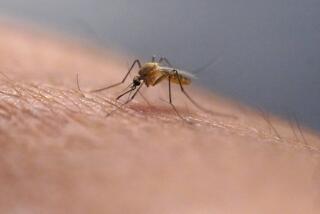Misunderstood âMosquito Hawkâ Sets Off a Buzz
Phone calls from residents, curious and worried, are pouring into the county environmental health office: What are these lanky, long-legged insects zooming through windows, climbing the walls and circling and careening like drunks around front porch lights? And why are there so many of them this year?
âCalls are coming in from all over Ventura County,â said Randy Smith, an environmental health specialist with the county, who has gotten dozens of queries about the insects in the last three weeks. âMost of the calls are from people who have seen them around their house, who believe they are very large mosquitoes.â
But mosquitoes they are not.
These oversize insects with the crazy flight patterns--known to scientists as crane flies and more popularly as mosquito hawks--donât buzz or bite. They are the gentle giants from the diptera order.
Also known by the scientific name tipulidae, these uncoordinated creatures come out every spring. But this year, due to lots of rain, followed by lots of warmth, there seems to be more of them, earlier.
âIt seems like there are zillions,â said Phil Phillips, an integrated pest management advisor with University of California extension in Ventura. âAnd there probably are.â
Entomologists say there is no way to quantify the increase, but Mark Westerline, district manager and entomologist for the Moorpark Mosquito Abatement District, has some real evidence.
Westerline has a couple of trap sites he watches. Normally this time of year he gets about 100 mosquito hawks in one 5-ounce glass jar. This year he has found double during his biweekly check.
âI havenât seen that many in one trap before,â he said. âI took them and measured them--and these guys were an inch long.â
And that does not count the legs. Adults can have spindly legs up to an inch and a half long and wings up to 2 inches across.
âA good rule of thumb,â Westerline said, âis with a true mosquito . . . you can take a dime and squash it. With a crane fly, it might take a quarter, or even a silver dollar.â
There are about 1,500 different types of crane flies across the United States, with about 400 in California.
Common crane flies have bodies up to an inch long. But locally, there are also âgiant crane flies,â with bodies up to an inch and a half long.
Entomologists say they are among the good bugs who nibble and fertilize, not the bad bugs, like mosquitoes, who need to suck blood to reproduce. There is no need to fear them--most adults canât eat. They canât even chew.
âPeople think, if this is a mosquito, itâs so big, what is it going to do when it bites me?â Phillips said. âBut it has vestigial mouth parts--parts that donât work.â
Crane flies are around all the time, but they are most frequently spotted between March and June when their numbers increase. They arrived earlier this year because of the warmer weather.
Adult flies plant their eggs in soggy spots such as organic gardens, leaky faucets or damp trash. The larvae feed in the soil on decaying vegetable matter.
The larvae are cylindrical brown or gray maggots--often referred to as âleather jacketsâ because of their tough skins. The larval stage can last a month or more. Once they become adults, most of them no longer eat. If they feed at all, it is on plant nectar.
They live only about two weeks as an adult. During that time they lay eggs. Then they die.
This was an especially good year because heavy, constant rain in January made for a bigger breeding ground.
As the soil begins to dry in the summer months, their habitat shrinks. So do their numbers.
Phillips said the important thing to remember is that they help the environment by recycling decomposing nutrients in the soil.
âThere is no need to mash them,â Phillips said. âThe adults can be aggravating. They are so clumsy when they fly that they bump into us. But they are very delicate and very easy to catch.â
He recommended taking them outside.
Smith, who works with the county, said the big awkward bugs are so harmless they have received little attention from researchers. Not even collectors like them, because their legs detach easily.
âThey donât cause any damage. They donât cause any public health problems,â Smith said. âSo no one has delved into studying them to a point where they have figured them out.â
FYI
Residents who want more information about bugs should call the Master Gardenerâs Hotline at 645-1455. Someone with basic entomology training will answer the phones between 2 and 4 p.m. on Tuesdays and Thursdays.
More to Read
Sign up for Essential California
The most important California stories and recommendations in your inbox every morning.
You may occasionally receive promotional content from the Los Angeles Times.










